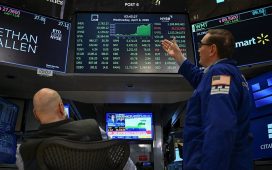Donald Trump’s tariff war has spooked stock markets and heightened fears of a recession in the US and Europe. But neither factor appears to have been what motivated the president’s sudden volte face this week, when he paused most of his “liberation day” border taxes for 90 days.
What is a bond?
A bond is a certificate confirming that its owner has lent money to a specified borrower that will be repaid at a fixed date, typically with a fixed rate of interest. Known as fixed-income securities, they appeal to investors who want stable returns.
Corporations issue bonds to borrow money and so do governments – to pay for investments and other expenditure. The UK government’s bonds are called gilts, while US government bonds are known as treasuries, traditionally seen as a safe haven because they are guaranteed by the world’s biggest economy. They are issued with different maturity dates when they must be paid off in full, with two-year, 10-year and 30-year bonds being common.
How are they traded?
Bonds can be bought and sold like shares on a secondary market – an exchange – but, unlike shares, they offer guaranteed annual returns. The bond market is the world’s biggest securities exchange, worth almost $130tn (£99tn), with the US market accounting for about 40% of debt worldwide.
Government bonds are usually sold to financial institutions in auctions, and can then be resold on the secondary market for more or less than their face value.
What is a bond yield?
Bond yields represent the amount of money an investor receives for owning the debt as a percentage of its current price. When the price of a bond falls, yields rise. The yield is commonly referred to as an interest rate, or the cost of borrowing to an issuer.
Rising yields suggest dwindling appetite to own the debt among investors, which can be influenced by a range of factors, including an issuer’s ability to repay. For governments, this centres on the prospects for the country’s economy and finances.
Inflation expectations also have a significant impact. This is because inflation undercuts the future value of money received for owning the debt. This means investors could demand a higher yield to compensate for the risk.
And because other financial products, such as mortgages, are priced off the yield, there is a spillover into the broader economy.
What have Trump’s tariffs done to bonds?
At first the US president considered his tariff plan to be working, having anticipated stock markets would react badly to tariffs and the dollar would fall.
However, Trump was sure the bond market would remain calm because he promised to pay for tax cuts later in the year with revenues from tariffs, meaning the US government could limit the number of bonds it issues, keeping supply and demand in sync and putting a cap on overall government debt levels.
However, the tariff war has prompted fears of a US recession, making it riskier to lend to the US. There are concerns that the US becomes locked in a titanic struggle with China, which damages both economies over a long period and drags down global growth.
In response, investors have sold US bonds in huge quantities, driving down their value and the yield higher, and making future government debt more expensive to issue.
Where did this leave Trump?
There was a fear in the White House that paying a higher interest rate on national debt would increase the government’s annual spending deficit, adding pressure to an already stretched budget and increasing the overall debt mountain.
Worse, the $29tn market in US treasuries is the bedrock of the global financial system and heavy selling could put pressure on other parts of the financial system, forcing banks or other institutions to default, causing a wider financial crisis.
Has the situation eased?
After the US president said he would suspend punitive tariffs on all countries other than China for 90 days, bonds markets began to settle. However, yields remain high, with the effective interest rate on a 10-year Treasury bond at 4.52% on Friday compared with 3.99% on 4 April.
Is this Trump’s Liz Truss moment?
The UK’s 49-day prime minister was brought down by her own skirmish with the bond markets, which considered her mini-budget to be reckless. That verdict sent the yield on UK gilts rocketing as bond values dropped like a stone, which forced mortgage companies to increase borrowing rates and wrecked Truss’s premiership.
While Trump has more resources, he faces similar concerns about the spillover effects. If his policies do drive up inflation as expected, with some analysts forecasting a rate of 4.5% by next year, that could alienate the republican core vote that brought him in on promises to cut soaring food prices. Voters could see tariffs as a tax on mortgages if banks start to charge more for home loans on the back of higher yields, denting his popularity with his base.












